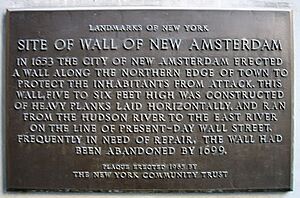Fortifications of New Netherland facts for kids

New Netherland, or Nieuw-Nederland in Dutch, was a colony established by the Dutch in the 1600s. It was located on the northeastern coast of North America, in what is now the East Coast of the United States. This large area stretched from southern Cape Cod down to parts of the Delmarva Peninsula. Today, the land that was once New Netherland includes parts of New York, New Jersey, Connecticut, Delaware, and Pennsylvania. The capital city of this colony was New Amsterdam, which was built on the southern tip of Manhattan island, near Upper New York Bay.
Contents
Exploring and Claiming the Land
The story of New Netherland began in 1609 when Henry Hudson explored the region. He was sailing for the Dutch East India Company, looking for a new route to Asia. After his journey, the area was carefully mapped and given the name "New Netherland" in 1614.
The Dutch named the three main rivers in the area:
- The Zuyd Rivier (South River), now known as the Delaware River.
- The Noort Rivier (North River), now known as the Hudson River.
- The Versche Rivier (Fresh River), now known as the Connecticut River.
The Dutch hoped to use these rivers to travel inland. They wanted to trade with the Native Americans for valuable furs, which was a very profitable business.
Setting Up Trading Posts
To officially claim land, countries needed to do more than just discover it. They also had to build forts and settlements. The Dutch decided to set up factorijen, which were like small trading posts. These posts had soldiers and a few settlers to protect the trade.
In the early years, the New Netherland Company built Fort Nassau on the North River. This fort was in the territory of the Mahican and Mohawk tribes. Other places where trading posts were likely set up include Schenectady, Schoharie, Esopus, Manhattan, Communipaw, Roodenburg, and Ninigret.
The Dutch West India Company Takes Over
In 1621, the Dutch West India Company (WIC) was given a special permission, called a charter, by the Dutch government. This charter allowed them to manage and profit from trade in New Netherland.
The first Dutch settlers arrived in 1624 on Noten Island. They began building defenses and populating the colony. The Dutch often named their forts after the House of Orange-Nassau, the royal family of the Netherlands. That's why you'll see names like Fort Nassau and Fort Orange for their forts around the world.
Dealing with New Sweden
In 1637, a new colony called New Sweden was started on land that the Dutch already claimed. The Dutch couldn't stop this at first and didn't officially recognize New Sweden. However, in 1655, the Director-General of New Netherland, Peter Stuyvesant, led a military mission. He took control of New Sweden, bringing it under Dutch rule.
That same year, the government made a rule that all settlers in New Netherland had to build stockades. These were strong fences or walls made of logs. They were meant to protect people if they were attacked. One of the largest stockades was built at Wiltwyck.
Important Dutch Forts
The Dutch built several forts to protect their trading interests and settlements. Here are some of the most important ones:
- Fort Nassau (1614): Located on the North River near what is now Albany, New York. It was later lost to floods.
- Fort Orange (1624): Built on Castle Island in the North River, also near Albany, New York.
- Fort Amsterdam (1625): This fort was built at the mouth of the Hudson River in New York Harbor, where Manhattan is today. The Alexander Hamilton U.S. Custom House now stands on its site.
- Fort Wilhelmus (1625): Located on the South River near Burlington Island, New Jersey. It was soon abandoned.
- Fort Nassau (around 1627): Near the South River at Gloucester City, New Jersey. It was moved in 1651 and became Fort Casimir.
- Fort Huis de Goede Hoop (1633): On the Park River near the Fresh River at Hartford, Connecticut.
- Fort Casimir (1651): Built on the South River at New Castle, Delaware. For a short time, it was called Fort Trefaldigheets (1654–1655) and later New Amstel.
- Fort Beversreede (1651): Located on the Schuylkill River near the South River in Southwest Philadelphia.
- Fort Altena (1655): This was the new name given to Fort Christina (at Wilmington) after the Dutch took it over from the Swedes.
Swedish Forts in the Region
Before the Dutch took control, the Swedes also built forts in the area they called New Sweden:
- Fort Christina (1638): Located at the Brandywine Creek and Christina River in Wilmington, Delaware. It was later renamed Fort Altena by the Dutch in 1655.
- Fort Mecoponacka (1641): In Chester, near Finlandia or Upland in Delaware County, Pennsylvania.
- Fort Nya Elfsborg (1643): Between present-day Salem Creek and Alloway Creek near Bridgeport, New Jersey.
- Fort Nya Gothenborg (1643): On Tinicum Island near the site of The Printzhof in Essington, Delaware County, Pennsylvania.
- Fort Nya Vasa (1646): At Kingsessing, on the eastern side of Cobbs Creek in Philadelphia.
- Fort Nya Korsholm (1647): On the Schuylkill River near the South River in Philadelphia.
Other Defenses and Settlements
Besides the main forts, other important defensive structures and settlements were established:
- Noten Eylandt (1624): Now known as Governors Island in New York Harbor.
- Fort Ninigret (around 1637): Located on the mainland north of Block Island in Rhode Island.
- Roodenburg (around 16??): Possibly a fort or trading post at the mouth of the Quinnipiac River.
- De Wal (1653): A wooden fence or wall, which is now the famous Wall Street in New York City.
- The Rondout (1657): Near the North River at Wiltwyck.
- Fort Bergen (1661): Built on top of Bergen Hill, part of Palisades in New Jersey.
- Gravesend, Brooklyn


